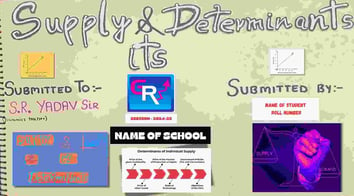Economics project on supply class 11
This blog post aims to simplify the process of creating an economics project on supply for Class 11 students. We will cover everything from survey design to the final presentation
SURVEY BASED ECONOMICS PROJECT
Introduction
Economics projects can be daunting, especially for those new to the subject. This blog post aims to simplify the process of creating an economics project on supply for Class 11 students. We will cover everything from survey design to the final presentation.
Structure of Your Economics Project
A well-structured project is essential for clarity and impact. Here's a breakdown of the key components:
Cover Page
Project title (e.g., "Supply and its determinants")
Your name, class, and roll number
submitted to
School logo
School name
Submission date
Image or relevant graphic
Acknowledgement Page
Express gratitude to teachers, parents, friends, or anyone who assisted in the project.
Keep it concise and sincere.
Certificate Page
A blank page to be filled by your teacher after evaluation.
Executive Summary
A brief overview of the entire project, including objectives, methodology, findings, and conclusions.
Keep it concise (usually one page).
Index Page
List of contents with page numbers for easy navigation.
Introduction to Statistics
Basic statistical concepts and meaning, types of data, questionnaires and quality of questionnaires.
Explain why these statistics are used in economic analysis.
Introduction to Supply and Its Determinants
Define supply, law of supply and its key determinants (price, technology, input prices, government policies, etc.).
Explain the relationship between supply and these factors.
Conducting Your Survey
Choose a product: Select a product to study (e.g., smartphones, agricultural produce).
Develop a questionnaire: Create clear and concise questions that gather relevant data.
Sample selection: Determine your target population and choose a representative sample.
Data collection: Administer the survey through online platforms, paper-based methods, or interviews.
Presenting Your Survey Data
Organize data: Tabulate and analyze the collected data using statistical methods.
Visual representation: Use graphs, charts, and tables to illustrate findings effectively.
Interpretation: Explain the trends and patterns observed in the data.
Conclusion
Summarize the key findings of your project.
Relate your findings to the economic theory of supply.
Recommendations
Based on your findings, suggest potential policies or strategies to improve supply.
Consider the practical implications of your recommendations.
Bibliography
List all the sources used for your project (books, articles, websites, etc.) in a standard format (APA, MLA, Chicago).
Viva Tips
Thoroughly understand your project.
Practice answering potential questions.
Be confident and articulate.
Dress appropriately.
Economics Project on Supply (Class 11) FAQs
Q: What is the basic structure of an economics project on supply?
A: A typical structure includes a cover page, acknowledgement, certificate, executive summary, index, introduction to statistics, introduction to supply and its determinants, survey methodology, data presentation, analysis, conclusion, recommendations, bibliography, and viva questions.
Q: How do I design an effective survey questionnaire?
A: Keep questions clear, concise, and relevant. Use a mix of open-ended and closed-ended questions. Pilot test your questionnaire before finalizing.
Q: How many respondents should I include in my survey?
A: The sample size depends on the target population. A generally accepted rule of thumb is a minimum of 30 respondents.
Q: How many respondents should I include in my survey?
A: The sample size depends on the target population. A generally accepted rule of thumb is a minimum of 30 respondents.
Q: What should be included in the conclusion?
A: Summarize key findings, relate them to economic theory, and highlight the significance of the study.
Q: How can I prepare for the viva?
A: Thoroughly understand your project, practice answering potential questions, and be confident.
Q: What kind of questions can I expect in the viva?
A: Expect questions about your research methodology, findings, conclusions, and their implications.


